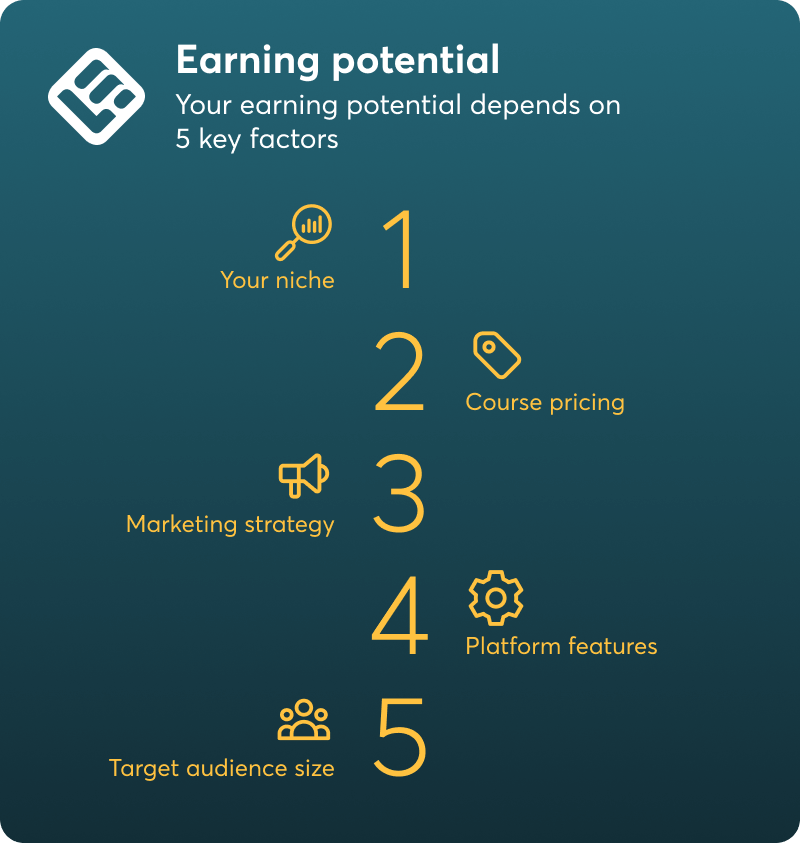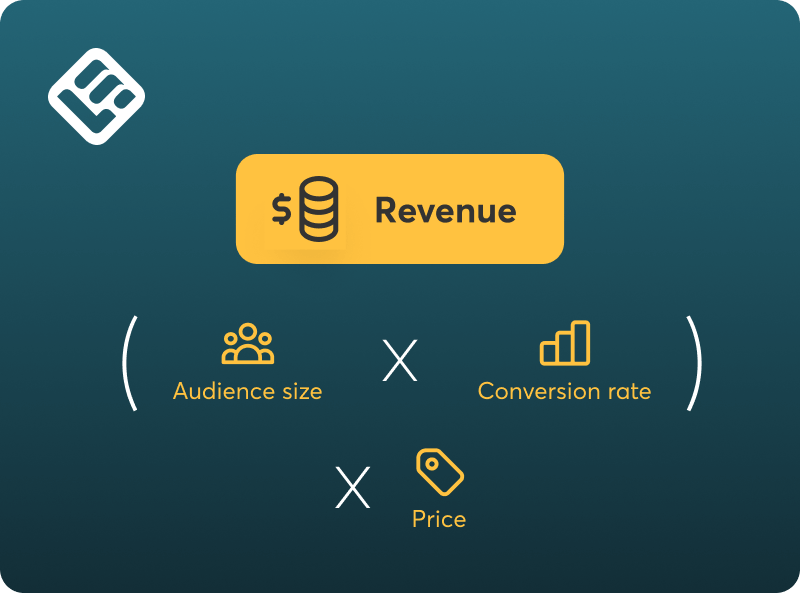Table of Contents
If you’ve ever wondered how much money you can make selling online courses, you’re not alone. With thousands of creators launching educational content every year, the question isn’t just “is selling courses profitable?”, but how profitable, for whom, and under what conditions.
This blog post breaks it all down. Whether you’re a solopreneur with a niche skill, a coach looking to scale, or someone who just wants to create a course, sell your course, and make money through online education, the opportunity is real.
I’ll walk you through:
Let’s dive in.
How much money can you make selling online courses? Profit potential at a glance
Want to know how much money you can make selling online courses in 2026? Whether it’s a side hustle or a full-time income, the earning potential is real. Here’s a quick look at what the data and real course creators are showing.
Spoiler: it ranges from side-hustle income to businesses generating thousands of dollars every month.
Your earning potential depends on five key factors: your niche, course pricing, marketing strategy, platform features, and the size of your target audience.

Let’s start with a snapshot of industry stats and real-world income ranges.
Industry growth stats
If you’re wondering whether you can earn money from an online course, the data speaks for itself. The online learning industry is growing rapidly, driven by demand for flexible education, upskilling, and creator-led training models.
These stats highlight why course creators—from solo entrepreneurs to established brands—are treating online education as a serious revenue opportunity:
All signs point to a strong and growing learning market, making it a great time to start creating online courses for profit.
Real-world income ranges from creators who make money selling online courses
Here’s what course creators who make money selling online courses are actually earning.
Whether you’re creating an online course as a one-time launch or growing a full online course business, aligning with market demand and refining your strategy is key.
Earn money with online courses: Quick revenue and profit calculator
Wondering how much money you can make selling online courses? Use the simple formula below to estimate your revenue based on audience size, conversion rates, and pricing.
You don’t need thousands of students to make money. Even a small, engaged audience can lead to a profitable online launch.
Input variables explained
Here’s what you need to know before running your numbers:
Sample scenarios
Let’s break this down with three common examples:
Scenario 1: Starter Course ($99)
Use case example: A LearnWorlds creator in the fitness niche launched a $99 self-paced course to an email list of around 900 subscribers. With a 3.5% conversion rate and zero ad spend, they made $3,115 in their first launch, purely through email marketing and a warm audience. They’ve since bundled it with a coaching upsell to increase average revenue per student.
Scenario 2: Flagship Course ($299)
Use case example: A LearnWorlds creator in the business coaching space launched a $299 flagship course on building an agency. With an email list of 2,400 and a warm-up webinar, they achieved a 4.1% conversion rate, generating just over $30K from their first launch.
They used an automated email funnel and included access to a private community to drive long-term engagement and referrals.
Scenario 3: High-Ticket Program ($1,000)
Use case example: A LearnWorlds creator in the career development niche offered a $1,000 high-touch course with coaching and personalized feedback. They promoted it to a list of 4,800 subscribers using a hybrid launch strategy (live webinars + evergreen email sequence).
With a 2.2% conversion rate, they brought in $104,000, and used a premium tier for clients needing additional support—unlocking even more revenue with minimal extra content creation.
Revenue formula you can use
To understand how much you can realistically earn when looking for online courses to make money, it helps to break revenue down into a simple formula:
Revenue = Audience size × Conversion rate × Price

This simple revenue formula helps clarify: Is selling courses profitable? Yes, but profit scales with pricing, targeting, and optimized email campaigns. Your success is more about alignment and strategy than just raw numbers.
How to make money selling courses online: Key factors that drive profit
Creating an online course is just the beginning. To make it profitable, whether you’re aiming for a side hustle or want to start selling courses full-time, you need more than a great idea. You need the right mix of market demand, pricing, marketing strategy, and a great learning experience.
Here’s what separates a profitable course from one that just sits online.
Course topic and audience fit
Not all course topics are created equal. The most successful online course creators start by validating their subject matter against what their target audience actively wants.
Here’s how to evaluate your idea:
Most profitable niches (for 2026):
The sweet spot? A niche you’re experienced in, and people are actively paying to learn, can help you find ideas for the best online courses to make money.
Pricing strategy
Here’s a hard truth: underpricing your course kills your profit.
Too many creators start with low prices, assuming it will be easier to sell. But this can backfire by attracting the wrong audience or signaling low value.
Use these pricing strategies instead:
Example: A flagship $1,000 course that helps learners build a freelance business can easily be justified if they earn even a single client.
💡Remember: the most profitable online course strategies aren’t just about traffic. It’s about pricing for impact.
Marketing and traffic
You could have the best course on the planet… but without traffic, it won’t sell. Here’s how to build visibility (even on a budget):
Combine organic content with automation. That way, even while you sleep, your marketing machine keeps working. Also, you don’t need a massive audience. But you do need a clear message and strong marketing efforts (like email marketing or content creation).
💡Keep learning: How to create an SEO-optimized online academy
Student results and social proof
If your students get results, your course will sell itself.
Here’s how to use that to your advantage and earn money from online courses:
When people see how your course works, they’re more likely to buy—and more willing to pay premium prices.
Boosting earnings: 7 proven tactics to make money with online courses
Already launched your course, or close to it? Good news: there are plenty of ways to increase revenue without starting from scratch. These tactics work especially well once you’ve validated your offer, and some even help creators build seven-figure revenue streams.
1. Upsells and bundles
Want to improve your course revenue instantly? Add an upsell.
Here are ideas that work:
Example: Instead of selling one $99 course, bundle three for $249 and increase average order value without extra acquisition costs.
2. Community-driven learning
People stick with courses when they feel supported.
Offer a community component such as:
Engagement metrics show that courses with strong community features often see higher completion rates and more referrals. That means better testimonials and more sales to make money with online courses.
3. Affiliate and influencer partnerships
You don’t have to do all the marketing alone. Let your happy students and relevant creators help you sell your course while you focus on creating content and improving outcomes.
Tips for successful affiliate marketing:
This tactic is especially effective if you’re not a full-time marketer but want to grow sales without more time investment.
4. Evergreen funnels and automation
One-time launches are exciting, but evergreen automation brings consistency.
Use these strategies:
Passive income from courses isn’t a myth. But it does require intentional systems.
5. Iterate and improve content
Here’s a secret the best creators know: great courses are rarely perfect at launch.
Regularly improve your course by:
Each improvement boosts retention, satisfaction, and word of mouth—which are essential ingredients for building a successful course that delivers long-term ROI.
6. Startup costs vs profit margins
Let’s get practical: Is selling online courses profitable after you account for your expenses?
Here’s a breakdown of the typical one-time and ongoing costs, and how much profit you can expect depending on your pricing model. Spoiler: most course creators see profit margins of 70–90%, which is far higher than physical products or coaching-only models.
One-time production costs
These are the upfront investments you’ll likely need to make:
💡Keep in mind: With an all-in-one online learning platform like LearnWorlds, many of these tools are already included, keeping your startup costs lower.
Ongoing expenses
Once you’re live, here’s what to budget for monthly:
Even with moderate expenses, most course sellers report a monthly overhead of $100–$400. That means if you’re making even $1,000/month, you’re already operating at a high margin.
7. High-margin digital product economics
Here’s where courses shine.
Once your course is built, the marginal cost of delivering it to a new student is basically $0. That’s the power of scalability.
You can sell your online course 1 time or 1,000 times with no extra cost per delivery.
Upsells, bundles, and affiliate traffic all multiply your revenue without multiplying your workload.
Compared to consulting or productized services, courses are among the most profitable online products, especially once your online course business is up and running.
Best online courses to make money: Most profitable niches right now
One of the biggest levers in course profitability is choosing the right topic. When there’s market demand and your course solves a real problem, you can charge premium prices and sell again and again.
While any niche can be profitable with the right positioning, these categories will outperform the rest in 2026.
Evergreen niches (business, finance, real estate)
These niches dominate because they help learners make money, transition careers, or develop technical skills like web development, a value that easily justifies a $299–$1,000 price tag.
Examples include:
These topics also tend to convert well with SEO content, email marketing, and YouTube tutorials that attract learners actively looking to improve their skills.
High-growth niches (AI, beauty, fitness, gaming)
These fast-moving markets offer huge opportunities, especially if you can create quality content faster than others in the space.
What’s trending now:
These niches often work well with social-first marketing strategies, such as TikTok, Instagram Reels, or live sessions that build trust quickly.
💡Pro tip: Combining a high-growth niche with a transformational outcome (eg “Learn AI tools for freelancers”) helps you create some of the best online courses to make money due to long-term demand.
Best-selling online courses: 13 ideas to earn income from home
The best-selling online courses typically focus on solving real problems, teaching in-demand skills, or helping learners achieve specific goals. If you have knowledge or experience in a field, you can turn it into a digital product and start earning income from home.
Here are the ideas for 13 courses to earn money from home.
Common mistakes that kill profitability when working with online courses for making money
Even with the best intentions, it’s easy to make decisions early on that limit your course’s potential. Here are the most common mistakes that stall revenue, and what to do instead.
Underpricing premium transformation
If your course helps people save time, increase income, or gain a competitive edge, don’t treat it like a $27 ebook.
Here’s why underpricing hurts when starting online courses for making money:
Instead, set the price based on transformation. A $1,000 course that helps someone land a new job is a bargain compared to what they’ll earn in return.
Ignoring market research
A great course on the wrong topic won’t sell. Make sure you:
The best creators always start with what their audience wants to learn, not just what they want to teach.
One-and-done launch mentality
Many creators launch once, get modest sales, and assume their course business failed. But the truth is: most successful online courses grow through iteration.
What to do instead:
Think of your course as a living product, not a one-time asset. That mindset shift alone can improve your course over time and drive long-term profitability.
Is selling courses the right model for you?
Selling online courses is profitable, but it’s not a guaranteed get-rich-quick path. It’s ideal for those who want to monetize their knowledge, build digital products, and reach students at scale. But it does require work upfront.
Use this checklist to evaluate if this is the right fit for you.
Ask yourself:
If you checked at least 4–5 of these, you’re already positioned to start selling. You don’t need to be a tech wizard or full-time marketer; you just need a clear plan and a commitment to improve your course after launch.
Not sure yet? Consider alternatives to selling online courses:
You can make selling online courses a meaningful part of your income, whether it’s a side hustle or your main business, especially when paired with automation and high-demand content.
Your next steps to make money from online courses
You’ve seen the numbers. You’ve explored the tactics. And you’ve answered the big question: Is selling courses profitable?
If you’re ready to start selling and make money from online courses, here’s how to move forward without getting overwhelmed.
Make money selling online courses with LearnWorlds
Still wondering, “Is selling online courses profitable?” The answer depends on your strategy, but the opportunity is growing. More learners are seeking flexible, self-paced learning—and they’re willing to pay for quality content.
So if you’re looking to make money selling online courses, LearnWorlds gives you the tools and flexibility to do it professionally—from your first sale to scaling a full education business. With a built-in flexible courses builder, sales funnels, branded websites, and learner analytics, you can monetize your expertise without relying on third-party marketplaces or giving up revenue share.
Start your 30-day free trial with LearnWorlds today and turn your expertise into a profitable online course business—no tech skills or hidden fees required.
Rosemary is LearnWorlds’ Content Marketing Manager. She has over 2 decades of experience in omnichannel marketing and content writing for the IT and SaaS industry. Her expertise lies in crafting effective content marketing strategies that attract, engage, and nurture customers, enabling LearnWorlds to reach its target audiences with precision.
Kyriaki is the SEO Content Manager at LearnWorlds, where she writes and edits content about marketing and e-learning, helping course creators build, market, and sell successful online courses. With a degree in Career Guidance and a solid background in education management and career development, she combines strategic insight with a passion for lifelong learning. Outside of work, she enjoys expressing her creativity through music.
FAQ
Everything you have ever wondered, but were too afraid to ask...
Good conversion rates for course sales are typically around 1-5%.
The best platforms to sell online courses should provide tools for marketing, sales, analytics, and learner engagement. Look for technology that supports multiple content types, payment gateways, and flexible pricing models.
LearnWorlds, for example, is the best solution for online course creation and monetization.
Our system gives you control over course structure, user roles, learner experience, and branded design—plus built-in tools for landing pages, upsells, and automation. Choosing the right platform directly impacts your ability to charge a higher price and grow your business sustainably.
💡Keep learning: Where to sell online courses: The top 6 platforms compared
To measure success in your online courses to earn money, include metrics like course completion rates, learner satisfaction, and customer retention. To get a full picture, track both financial and engagement key performance indicators (KPIs).
Key online course metrics include:
Platforms like LearnWorlds offer detailed analytics and reports, helping you tie learning outcomes to income—so you can optimize every part of your online course creation journey for long-term success.
Selling courses to earn money online offers a scalable, low-overhead way to generate income while sharing your expertise. Once your course is built, it can be sold repeatedly with minimal additional effort, creating opportunities for passive or recurring revenue.
Key benefits of selling courses to earn money online include:
💡Keep learning: 37 AI writing tools to create and market your online course
To price an online course for profit, consider your course's value, your audience’s willingness to pay, and your business goals. Pricing too low can reduce perceived value, while pricing too high without proof of outcomes may limit conversions.
Use LearnWorlds’s solutions to test different pricing tiers, bundle offerings, and upsell strategies to improve profit margins while maintaining learner value.






